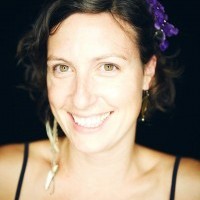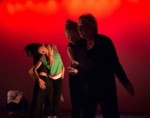“Finding Oneself” Through Asking
In Conversation: Meg Foley and Megan Bridge
Meg Foley: How long have you lived in Philadelphia?Megan Bridge: I moved to Philly full time when I graduated from college in the year 2000. And before that I spent summers and winter breaks from school in Philadelphia since 1997.
MF: And why did you move here?
MB: I’m originally from the suburbs of Philadelphia and already in High School I started working with a company that was here at the time called Convergence Dancers and Musicians. All through college I was coming back to visit, seeing a lot of performances, taking dance classes and engaging in the dance community. I had a relationship with this one company and my now husband was writing a lot of music for dance. I already had a foot in the Philadelphia dance community and when I graduated I wanted to live with my partner so it was an easy choice to come back here.
MF: Aside from the immediate opportunities that Philadelphia offered you, were there any aesthetically related factors in your choice to move here?
MB: I saw Philadelphia as a place where there were more opportunities in general, particularly the Philadelphia Fringe Festival [now split into the Philadelphia Live Arts Festival and Philly Fringe] which at that point was accepting applications from anyone and was producing a lot of local choreographers, and they produced me that fall right out of college.
Because those opportunities, I felt that Philadelphia was a place where one could experiment and make work that was maybe more on the outside of a traditional genre. The stuff that I was more interested in aesthetically was a little more image-based and conceptual and theatrical. And there definitely was a lot more of that going on in Philly at the time [in 2000].
MF: So it seems you settled here in part because you saw a place for yourself. I would consider
MB: In some regards, I think there is this drive in Philadelphia for people’s work to be entertaining and accessible and I think we’re also experiencing that drive in other areas. There is the buzzword “clarity,” which translates into people being able to get what you mean really easily and not having to think too hard. The work that I’m interested in making is difficult, on purpose. The work that I want to see and I want to make pushes thought, forces thought. I don’t want people to say, “Ugh, I have to think so hard to get this thing.” Because I don’t feel like there is an underlying “thing” to be figured out. I just want people to think more, and I want people to think harder. I want to think harder. I like to be drawn into thought.
MF: When you start to make a work are you able to write down the questions you are asking?
MB: Sometimes. In 2008 I made a piece called Subject in Two Parts, and I was thinking about the concept of subject/object and wondering where “self” fit into this question. Is it possible to have a subject? Does it exist? Is there a self underneath all these layers of what makes us us: acculturation, media, and so on?
MF: I recently heard Paula Marincola state in a community discussion that any artist making work that is transdisciplinary, cross-disciplinary, interdisciplinary – whatever buzz word you want to use – is responsible for knowing what is happening at the forefront of all involved media. What do you think of that?
MB: To some extent I agree with that statement. I think that at least for example if I was going to make a cross-disciplinary work and I was the creator or director of the work I would want to have lead collaborators who I felt had a good knowledge of what was going on in their field.
MF: I think Marincola was commenting on innovation, which is a line you are drawing as well. Can you talk about the relationship between subjectivity and innovation and research in other fields?
MB: I don’t think the reason that you need to know about what’s happening in other fields is so that you don’t repeat. To repeat is inevitable. It’s not that I don’t believe in innovation, I just don’t believe in it as an end. I have a little bit of an ambivalent feeling towards innovation or [laughter] maybe I’m just against innovation period.
I’ve been really against creating movement. When you strip away all the layers of other, is there anything left? In that way the innovation question and the subject question go hand in hand. How can “I” create anything new if there isn’t really an “I” in the first place? If the “me” is just made up of pieces of everything else, how could I possibly claim to make something totally new, and why would I want to? My interest as an artist is in taking everything that’s around me and reflecting it back.
MF: So how does this relate to your process? Would you say that when you’re outside of it, you’re able to get closer to the “I” than when you’re inside of it?
MB: I was finally able to confront this question about subject and invention and innovation after I made this long solo piece, The Fold, in 2006. When I look at the video I realize that all of the movement is this recycled stuff from my career as a dancer and it’s really uninteresting for me to watch, movement-wise. That was a turning point in my work. The work that I’ve made on other people, I like much more, I like watching much more. When I’ve made work on other people it tends to be – and I still have this problem, have had this problem for years, or maybe it’s not a problem – the work I’ve made on other people is much more conceptual, image-based, and not kinetic. And then I do this solo work that’s really physical, and when I choreograph it I end up hating the movement even though it might feel really good.
I think what happens to me as a maker is that when my body is in the work, I have a really hard time asking some of the conceptual questions I’m interested in because I get so distracted by the layers of movement I’ve accumulated as a dancer over the course of my career. They get in the way almost. And when I’m outside of it, I’m much more able to arrange things in ways that interest me. Actually I feel like when I’m outside of the work I make work that is much more me.
By Megan Bridge
April 26, 2012










